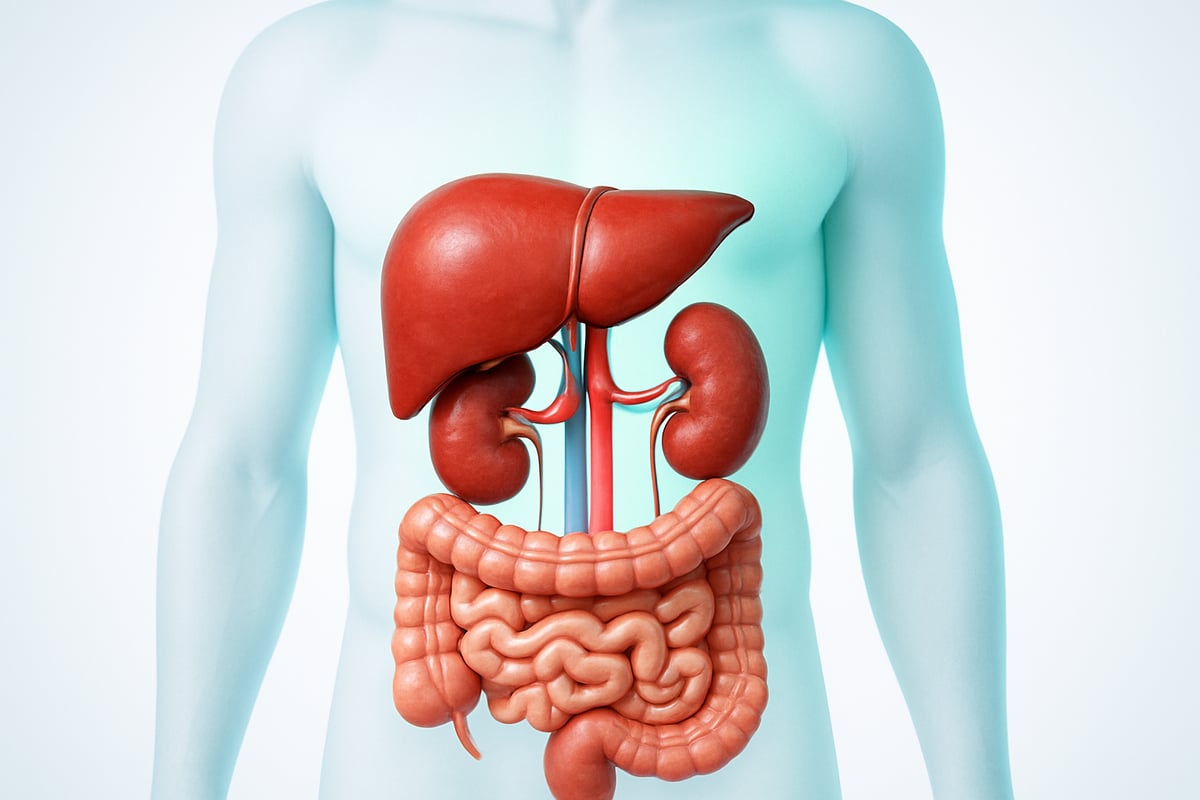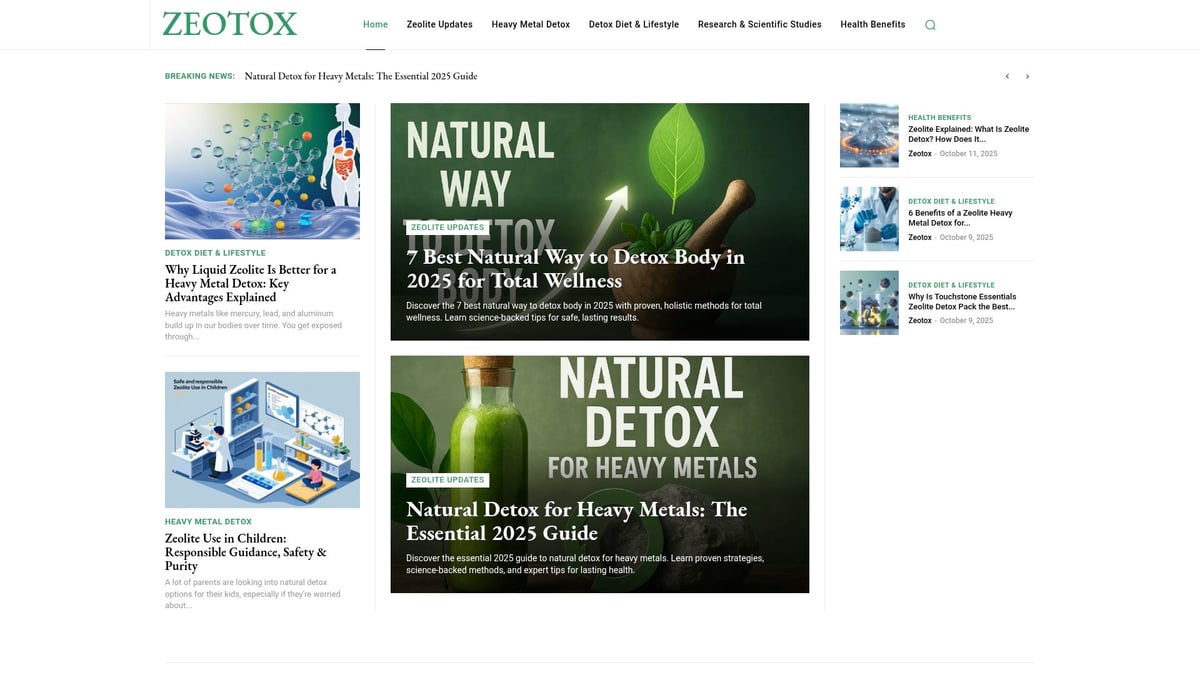Are you worried about the hidden risks of heavy metals in your daily environment? As new research emerges for 2025, understanding how to safely approach heavy metal body detox has never been more important.
This guide delivers clear, up-to-date strategies to help you support your body’s natural detoxification process and minimize heavy metal exposure. By focusing on evidence-based steps, you can take control of your health with confidence.
Explore what heavy metals are, how they affect well-being, ways to recognize symptoms, and the safest detox methods. Let’s begin your journey toward a healthier, safer future.
Understanding Heavy Metals and Their Impact
Heavy metals are a growing concern in our environment and daily lives. To understand the importance of heavy metal body detox, it is crucial to look at what these metals are, how they affect our health, and where exposure commonly occurs today.

What Are Heavy Metals?
Heavy metals are elements with a high atomic weight and density that can be toxic even at low concentrations. Common examples include lead, mercury, cadmium, arsenic, and aluminum. These metals enter our bodies through contaminated water, polluted air, certain foods, and household products. For instance, the Flint water crisis revealed how lead from old pipes can impact entire communities.
Not all metals are harmful. Some, like zinc and iron, are essential for health, while others are toxic even in small amounts. In 2025, environmental contamination remains a widespread concern, making heavy metal body detox more relevant than ever. Understanding the distinction between essential and toxic metals is key to protecting your health.
How Heavy Metals Affect the Body
Heavy metals can accumulate in tissues over time, a process called bioaccumulation. This persistence means that even small exposures can add up and interfere with vital cellular processes, disrupt enzymes, and increase oxidative stress.
The effects of heavy metals are especially pronounced in vulnerable populations, such as children, pregnant women, and the elderly. Chronic exposure can lead to fatigue, cognitive decline, and even organ dysfunction. According to reports from the CDC and WHO, heavy metal body detox is a growing area of interest due to the potential for long-term health effects.
Signs and Symptoms of Heavy Metal Toxicity
Recognizing the signs of heavy metal toxicity is challenging, as symptoms often overlap with other health issues. Common signs include ongoing fatigue, headaches, digestive problems, and brain fog. Less obvious indicators might be skin changes, mood swings, or reduced immune function.
Accurate diagnosis typically requires medical testing, since symptoms alone are not definitive. It is important not to self-diagnose or attempt extreme detox methods without professional guidance. For a comprehensive overview of causes, symptoms, and treatments, refer to the Heavy Metal Poisoning Overview.
Sources of Exposure in 2025
In 2025, sources of heavy metal exposure include tap water from aging infrastructure that may contain lead or copper, industrial emissions, pesticides, and contaminated foods like certain fish or rice. Cosmetics and personal care products can also introduce metals such as aluminum into the body.
Occupational hazards remain a risk for some workers, and recent statistics show that environmental exposure trends are not declining. Understanding these sources is a vital first step in any heavy metal body detox plan. Staying informed and proactive helps reduce daily exposure and supports long-term health.
The Body’s Natural Detoxification Systems
Our bodies are equipped with remarkable systems designed to process and remove toxins, including heavy metals. Understanding how these natural detoxification pathways function is essential for anyone considering a heavy metal body detox. Let’s explore how these organs work together and what you can do to support their efficiency.

How the Liver, Kidneys, and Colon Work
The liver, kidneys, and colon form the core of your body's internal detox team. The liver acts as a primary filter, breaking down toxins, including heavy metals, and producing bile for elimination. Kidneys filter blood, excrete waste, and regulate minerals, playing a vital role in heavy metal body detox. The colon absorbs nutrients and removes solid waste, ensuring toxins exit efficiently.
- Liver: Filters blood, neutralizes toxins, supports immune function
- Kidneys: Balance fluids, filter waste, maintain mineral levels
- Colon: Absorbs water, expels solid waste, houses beneficial bacteria
Maintaining the health of these organs is foundational for effective heavy metal body detox. Medical experts emphasize that supporting these systems naturally is safer and more sustainable than relying on quick fixes.
Limits of Natural Detox
While the body’s detox systems are robust, they are not infallible. Environmental pollutants and heavy metals can exceed what these organs can process, especially if exposure is ongoing. Factors like dehydration, inadequate nutrition, or chronic illness can reduce their efficiency and limit the success of a heavy metal body detox.
In some cases, the body cannot keep up, and medical intervention may be needed. According to Natural Detox for Heavy Metals, natural strategies are effective for mild to moderate exposure, but severe cases require professional evaluation. Research consistently shows that extreme cleanses do not outperform the body’s natural systems when supported with healthy habits.
Lifestyle Factors That Support Detox Organs
Daily habits have a direct impact on your body’s detox capacity. Proper hydration keeps kidneys and liver functioning optimally. Quality sleep allows for cellular repair and toxin clearance. Regular movement, such as walking or yoga, promotes circulation and helps the lymphatic system carry out waste.
- Hydrate: Aim for 8-10 cups of water daily
- Sleep: Prioritize 7-9 hours each night
- Exercise: Engage in moderate activity most days
- Avoid toxins: Limit alcohol, tobacco, and processed foods
- Manage stress: Practice mindfulness or relaxation techniques
A lifestyle built on these habits strengthens your heavy metal body detox systems, reducing your long-term risk.
Myths and Misconceptions About Detox
Detox trends often promise fast results, but many are unsupported by science. Juice cleanses and extreme fasting may offer temporary weight loss, but they do not enhance heavy metal body detox. The medical community advises caution with over-the-counter detox supplements, as some may carry risks or lack proven benefits.
Beware of claims that suggest you can “flush out” all toxins in days. Effective detox is a gradual, evidence-based process. Misleading marketing often overlooks the importance of organ health and sustainable lifestyle changes. Focus on proven, safe methods rather than fads for lasting results.
Safe Methods for Heavy Metal Detox in 2025
Looking for safe, practical ways to start a heavy metal body detox this year? Science continues to evolve, and 2025 brings new tools and insights to help you protect yourself from harmful exposures. By following these five evidence-based steps, you can confidently support your body’s natural detoxification and minimize risks.
Step 1: Reduce Ongoing Exposure
The first step in any heavy metal body detox is to limit new sources of exposure. Start by filtering your drinking water using reverse osmosis or carbon filters. Choose organic produce when possible, and avoid high-mercury fish like swordfish and king mackerel.
Switch to non-toxic cookware, such as stainless steel or glass, to avoid added metals from old pots and pans. Check your local water quality reports for lead and other contaminants, and consider replacing aging plumbing if you live in an older home. Taking these precautions helps lower the burden on your body and sets a strong foundation for detox.
Step 2: Optimize Nutritional Support
Your diet plays a crucial role in heavy metal body detox. Focus on nutrient-rich foods that support detoxification, such as cruciferous vegetables (broccoli, Brussels sprouts), garlic, cilantro, and fiber-rich fruits. These foods have been shown to help bind and eliminate toxins naturally.
Key nutrients like vitamin C, selenium, zinc, and glutathione help protect cells and support your organs. A balanced, whole-food meal plan is essential. Try including a colorful salad with leafy greens and a citrus dressing, or a smoothie with berries and flaxseed, to boost your daily detox potential.
Step 3: Consider Natural Detox Aids
Natural supplements can further support your heavy metal body detox, but always consult a healthcare provider before starting. Chlorella and spirulina are well-researched microalgae known for their ability to bind certain metals. Milk thistle may help protect liver cells during detox.
Fiber and probiotics also play a role by promoting regular elimination and supporting gut health. Avoid untested or extreme detox products, and look for brands that provide third-party testing and clear ingredient labels. For a comparison of popular natural detox aids, see Comparison of Shilajit and Zeolite for Detox.
Step 4: Support Elimination Pathways
Proper elimination is essential for heavy metal body detox. Stay well-hydrated by drinking at least eight cups of filtered water daily. Regular exercise, such as brisk walking or yoga, stimulates circulation and lymphatic flow.
Sauna sessions can encourage sweating, which may help release some toxins, but always follow safety guidelines. Ensure you get enough dietary fiber to maintain regular bowel movements. Avoid constipation and dehydration, as both can slow the removal of toxins from your system.
Step 5: Work With Healthcare Professionals
Partnering with a qualified healthcare provider is key for a safe heavy metal body detox. If you suspect exposure, ask about medical testing options like hair, blood, or urine analysis. Some cases may warrant chelation therapy, but this should only be done under medical supervision, as it carries risks.
Integrative and functional medicine practitioners can help tailor detox protocols to your needs and monitor your progress. Avoid self-administered chelation or unproven treatments, as these can be dangerous.
Zeotox: Science-Backed Zeolite Detox Information
Zeolite is a natural mineral gaining attention for its potential role in heavy metal body detox. Research suggests that high-purity, lab-tested zeolite may help bind and remove certain metals from the body.

When choosing a zeolite supplement, look for products that provide laboratory analysis and safety data. Zeotox offers evidence-based education, product recommendations, and practical tips for incorporating zeolite into a holistic detox plan. Always integrate zeolite as part of a broader, balanced strategy, and consult a professional for guidance.
Diet and Lifestyle Strategies for Ongoing Protection
Taking a proactive approach to heavy metal body detox can make a meaningful difference in your long-term health. By focusing on daily habits and mindful choices, you can support your body’s natural defenses and minimize ongoing exposure. Let’s explore the practical strategies that empower you to maintain a cleaner, safer internal environment.

Eating for Detox: What to Include and Avoid
Diet is your first line of defense for heavy metal body detox. Focus on anti-inflammatory, antioxidant-rich foods such as berries, dark leafy greens, and nuts. Cruciferous vegetables like broccoli and Brussels sprouts help support natural detoxification pathways.
- Include: organic produce, fiber-rich fruits, wild-caught salmon, garlic, and cilantro.
- Avoid: processed meats, high-mercury fish (like swordfish and tuna), non-organic grains, and canned goods with BPA linings.
- Prioritize: whole foods over packaged items.
A sample shopping list includes kale, blueberries, quinoa, walnuts, and avocados. Research consistently links a clean, plant-based diet to a reduced heavy metal burden. For more insights and recipes, explore Detox Diet and Lifestyle Strategies.
Hydration and Water Quality
Proper hydration is essential for effective heavy metal body detox, as water flushes toxins through the kidneys and supports cellular processes. Aim for filtered or purified water, using reverse osmosis or carbon filtration systems to remove contaminants.
- Assess your home’s water quality with local reports.
- Avoid bottled water when possible, due to microplastics and inconsistent purity.
- Consider stainless steel or glass containers for storage.
Real-world events, like city water contamination, highlight the importance of vigilance. Clean, safe water is foundational for ongoing detoxification.
Physical Activity and Detox
Physical activity boosts circulation and lymphatic drainage, both vital for heavy metal body detox. Regular movement encourages the elimination of toxins through sweat and supports organ function.
- Try: brisk walking, yoga, rebounding, and moderate strength training.
- Aim for: at least 150 minutes of activity per week.
- Adapt: routines to your fitness level and preferences.
Studies show exercise enhances the body’s ability to remove toxins. Gentle movement is effective and safe for most people, supporting holistic detox goals.
Environmental and Household Changes
Your environment plays a significant role in heavy metal body detox. Reducing indoor air pollution and minimizing exposure to toxic substances at home is crucial.
- Use HEPA filters and ventilate living spaces.
- Select non-toxic cleaning and personal care products.
- Manage dust, mold, and moisture to prevent contamination.
- Store food in glass or stainless steel containers.
Statistics reveal that indoor pollution can be a major source of heavy metal exposure. Simple changes, like swapping out old cookware and improving ventilation, offer lasting protection.
Mind-Body Approaches to Enhance Detox
Mind-body practices can further support heavy metal body detox by reducing stress and enhancing overall wellness. Chronic stress impairs detox pathways, so prioritizing relaxation is essential.
- Practice: meditation, breathwork, and mindfulness.
- Maintain: consistent sleep routines for optimal recovery.
- Build: a supportive community focused on healthy habits.
Integrative wellness strategies, including a balanced lifestyle and ongoing education, offer the best long-term results. For more on protective approaches, see Heavy Metal Exposure and Health Effects.
Frequently Asked Questions About Heavy Metal Detox
Navigating the topic of heavy metal body detox can be confusing. Below, you’ll find clear answers to the most common questions, helping you make informed choices about your health and wellness.
Is Heavy Metal Detox Necessary for Everyone?
Not everyone needs a heavy metal body detox, but certain groups are at higher risk. People working in industries with metal exposure, residents in areas with contaminated water, and those eating high levels of certain fish may benefit from routine assessment. Studies, such as the Association of Heavy Metals with Mortality, highlight increased risks for affected populations. For most people, prevention and periodic checks are more important than frequent detox. Always consider your personal risk factors and consult a healthcare provider for personalized advice.
How Can I Tell If I Have Heavy Metal Toxicity?
Symptoms of heavy metal toxicity often overlap with other health issues. Fatigue, headaches, digestive changes, and skin problems are common, but not exclusive to this condition. To confirm if you need a heavy metal body detox, medical professionals may recommend tests like blood, urine, or hair analysis. At-home kits are available, but their accuracy can be limited. For a reliable diagnosis, always involve a qualified health practitioner and avoid self-diagnosis based on symptoms alone.
Are There Any Risks to Detoxing?
While natural approaches to heavy metal body detox are popular, some methods carry risks. Overuse of supplements, aggressive chelation therapies, or unproven products may cause harm, interact with medications, or worsen health conditions. For example, natural minerals like zeolite have shown promise, but only lab-tested, pure products should be considered. Learn more about safe options in this Zeolite’s Role in Heavy Metal Detox guide. Always consult a healthcare provider before starting any detox protocol.
What Are the Most Effective Long-Term Strategies?
The most effective approach to heavy metal body detox focuses on prevention and supporting your body's natural systems. Key strategies include reducing exposure to contaminated water and foods, maintaining hydration, eating a nutrient-rich diet, and exercising regularly. Periodic risk assessments and working with healthcare professionals help track your progress. Sustainable, evidence-based habits offer the best long-term protection and keep your detox pathways functioning optimally.
After exploring how heavy metals can impact your health and the science-backed steps you can take to protect yourself, you might be wondering how to put these strategies into action safely. At Zeotox, we’re committed to helping you make informed choices about zeolite-based detox, guided by the latest research and expert advice. If you’re ready to take the next step toward a cleaner, healthier body in 2025, I encourage you to Download Your Free Zeolite Detox Guide for practical tips, evidence-based recommendations, and everything you need to start your detox journey with confidence.